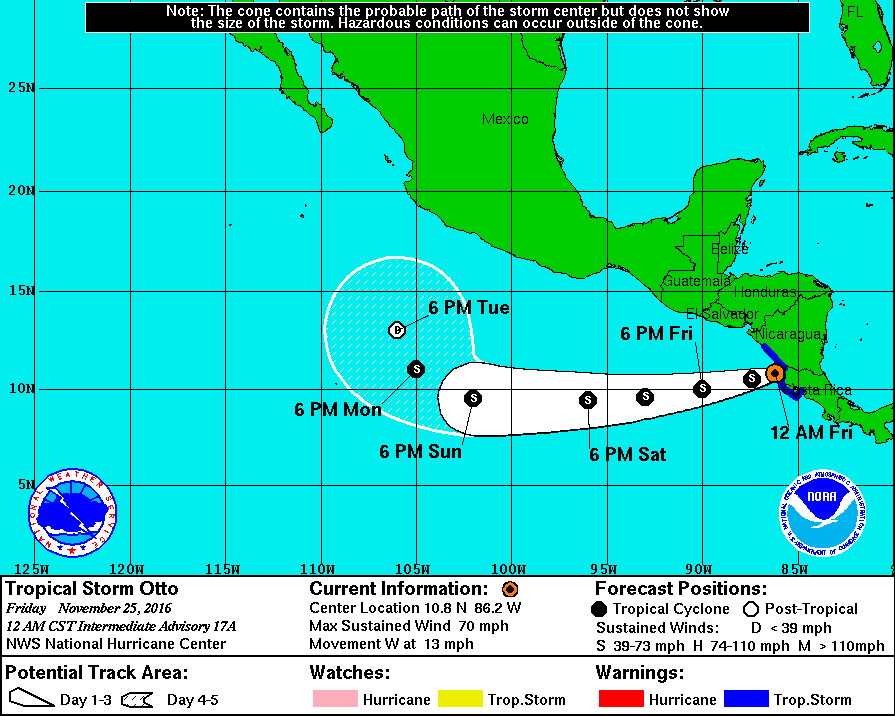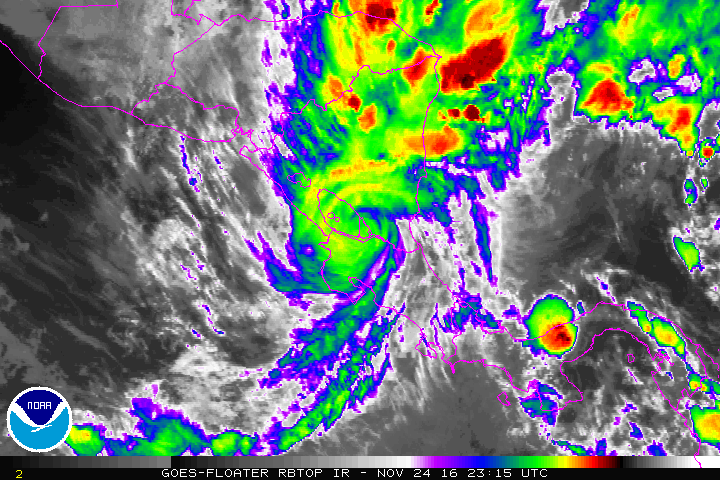簽到天數: 3291 天 [LV.Master]伴壇終老
|
 t02436|2016-11-25 14:40
|
顯示全部樓層
t02436|2016-11-25 14:40
|
顯示全部樓層
通知09Z改編號報文
000
WTNT41 KNHC 250254
TCDAT1
TROPICAL STORM OTTO DISCUSSION NUMBER 17
NWS NATIONAL HURRICANE CENTER MIAMI FL AL162016
900 PM CST THU NOV 24 2016
Radar data from Las Nubes, Nicaragua, indicate that the core of Otto
has remained well organized since landfall, with an eye still
discernible. On the other hand, the convective clouds associated
with the cyclone have warmed considerably since landfall. There
have been no surface observations from the core, so the initial
intensity is reduced to a somewhat uncertain 60 kt based on the
decay in the satellite appearance.
The initial motion estimate is 265/11. Otto is located over
northwestern Costa Rica and should emerge into the Pacific during
the next few hours. Easterly steering flow on the south side of a
deep-layer ridge located over the northwestern Caribbean Sea and
southern Mexico is expected to keep Otto moving in a westward to
west-southwestward direction for the next 72 hours or so. After
that time, the cyclone or its remnants are expected to reach the
end of the ridge and turn northwestward. The new forecast track is
similar to the previous track through 72 hours, then is shifted a
little to the left of the track based on a shift in the consensus
models.
During the first 36 hours over the Pacific, Otto is likely to be
over warm sea surface temperatures in an environment of moderate to
strong easterly vertical wind shear. The intensity forecast during
this time will show a slow weakening in agreement with the previous
forecast due to the uncertainties in the strength of the shear.
However, given the level of organization it would not be surprising
if some intensification occurred. Around 48 hours, the cyclone is
likely to encounter cooler sea surface temperatures which should
cause a faster weakening. From 72-120 hours, Otto is expected to
move over warmer water with decreasing shear at the same time it
encounters a much drier air mass. The intensity forecast uses the
premise that the dry air will cause the system to decay and thus
calls for Otto to be a remnant low by 120 hours. It should be
noted, though, the the intensity forecast after 48 hours remains
near the lower edge of the guidance.
The primary threat from Otto will continue to be torrential
rainfall, which will result in dangerous flooding and mudslides.
Since Otto has maintained itself as a tropical cyclone all the way
across the land mass of Central America, based on National Weather
Service and World Meteorological Organization protocols, it will
retain the name Otto when it moves over the eastern Pacific in a few
hours. Product headers will change to eastern Pacific headers
beginning with the next complete advisory at 0900 UTC. The
intermediate advisory at 0600 UTC will be issued under an Atlantic
header. The ATCF identifier will change from AL162016 to EP222016
at 0900 UTC.
FORECAST POSITIONS AND MAX WINDS
INIT 25/0300Z 10.9N 85.6W 60 KT 70 MPH...INLAND
12H 25/1200Z 10.5N 87.4W 55 KT 65 MPH...OVER THE PACIFIC
24H 26/0000Z 10.0N 90.0W 55 KT 65 MPH
36H 26/1200Z 9.6N 93.0W 50 KT 60 MPH
48H 27/0000Z 9.4N 96.0W 45 KT 50 MPH
72H 28/0000Z 9.5N 102.0W 45 KT 50 MPH
96H 29/0000Z 11.0N 105.0W 40 KT 45 MPH
120H 30/0000Z 13.0N 106.0W 30 KT 35 MPH...POST-TROP/REMNT LOW
$$
Forecaster Beven
06Z已經進入東太平洋
BULLETIN
TROPICAL STORM OTTO INTERMEDIATE ADVISORY NUMBER 17A
NWS NATIONAL HURRICANE CENTER MIAMI FL AL162016
1200 AM CST FRI NOV 25 2016
...CENTER OF OTTO NOW OVER THE EASTERN PACIFIC OCEAN...
...DANGEROUS FLOODING RAINS CONTINUING OVER PORTIONS OF COSTA RICA
AND NICARAGUA...
SUMMARY OF 1200 AM CST...0600 UTC...INFORMATION
-----------------------------------------------
LOCATION...10.8N 86.2W
ABOUT 55 MI...90 KM WNW OF LIBERIA COSTA RICA
MAXIMUM SUSTAINED WINDS...70 MPH...110 KM/H
PRESENT MOVEMENT...W OR 265 DEGREES AT 13 MPH...20 KM/H
MINIMUM CENTRAL PRESSURE...990 MB...29.24 INCHES


|
|